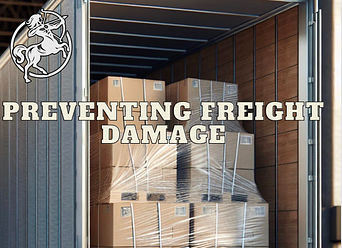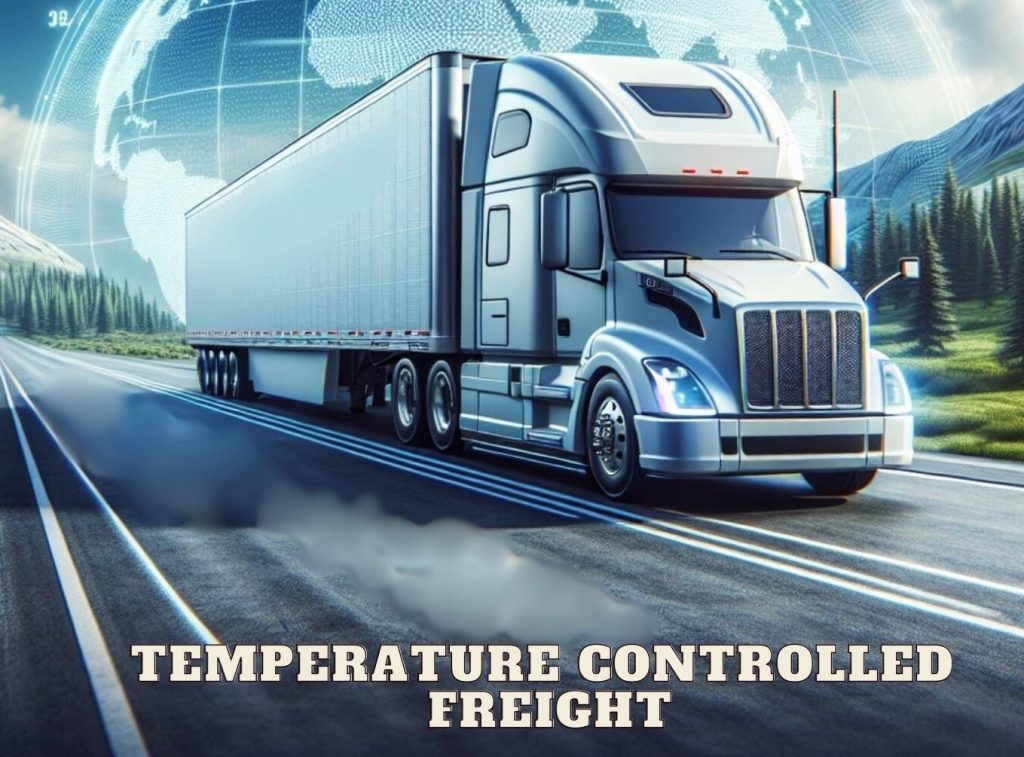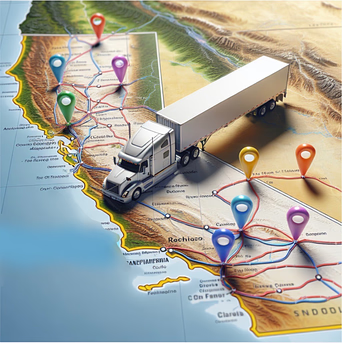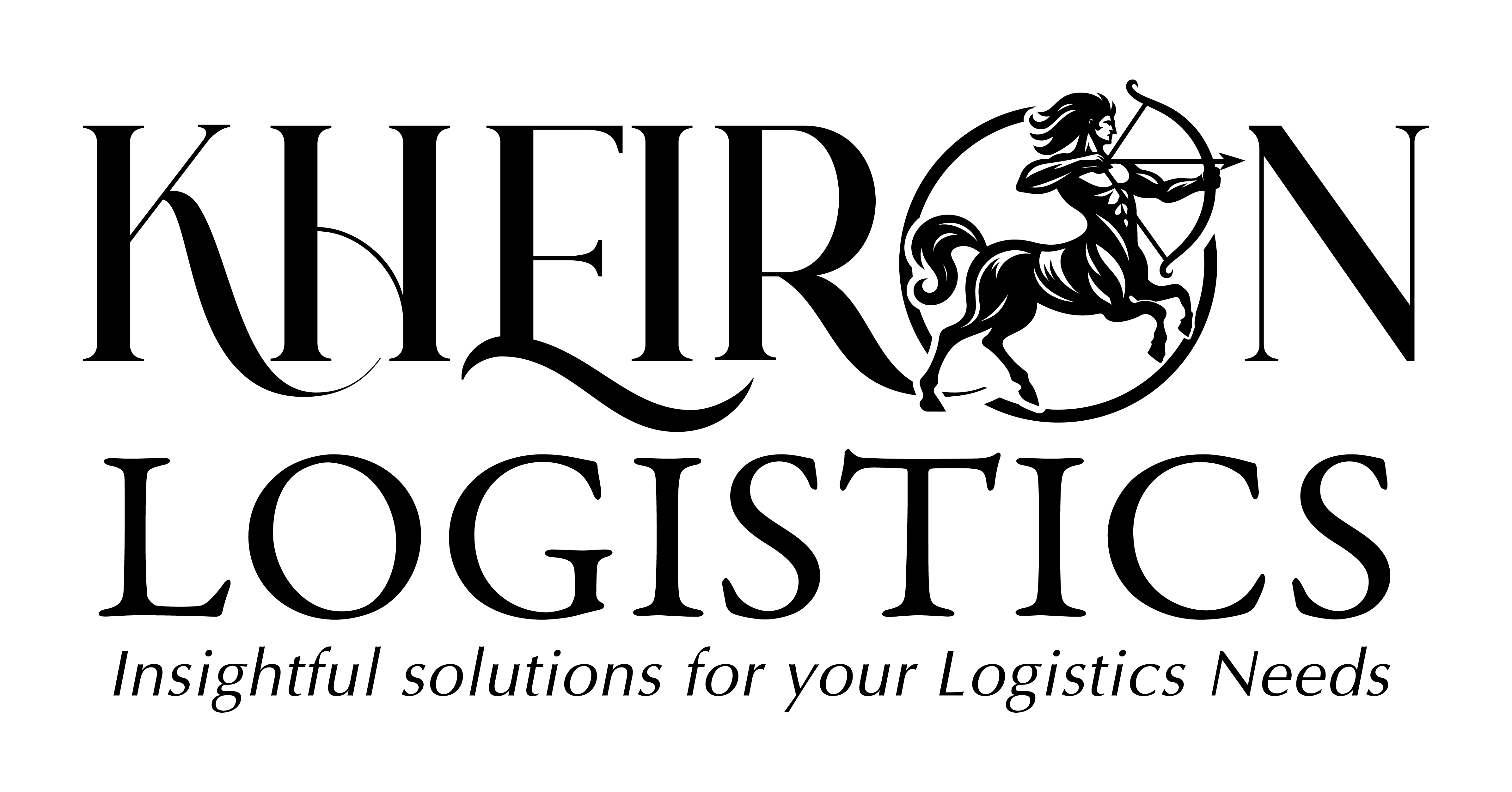Preventing Freight Damage

STRATEGIES TO ENHANCE YOUR SHIPPING PROCESS In the ever-evolving world of logistics and supply chain management, preventing freight damage is paramount to maintaining shipping integrity and ensuring customer satisfaction. Accidents may be inevitable, but with the right shipping best practices and packaging tips, you can significantly reduce the risk of damage during transit. By focusing on high-quality packaging materials, implementing rigorous load handling procedures, and partnering with reliable carriers, you can enhance your shipping process and safeguard your goods. As shippers, carriers, and business owners, adopting these strategies will not only protect your freight but also elevate your brand’s reputation in the industry. Let’s dive into effective logistics solutions that will empower you to deliver excellence and build confidence in your shipping operations. Understanding Freight Damage Common Causes of Freight Damage Freight damage often stems from several common causes that can be addressed to enhance shipping integrity. Improper packaging is a leading factor, where inadequate materials fail to provide sufficient protection. Incorrect labeling also plays a significant role, leading to mishandling during transit. Poor load handling practices, such as overloading or uneven weight distribution, can compromise cargo stability. Additionally, using inappropriate or damaged pallets can result in structural failure under the load’s weight. Environmental factors, like extreme temperatures and humidity, can also affect sensitive goods if not accounted for. Finally, human error, including inadequate training and lack of awareness, contributes to mishaps. Recognizing these causes is the first step toward implementing effective logistics solutions that prevent freight damage. By addressing these issues, businesses can reduce incidents and improve overall supply chain management. Impact on Business Operations Freight damage has significant implications for business operations, affecting both financial performance and customer relationships. Damaged goods often lead to increased costs due to replacement expenses and additional shipping, impacting profit margins. Moreover, frequent incidents of freight damage can strain relationships with clients, as customers may experience delays or receive inferior products, leading to dissatisfaction and potential loss of business. These disruptions can affect brand reputation, as word-of-mouth and reviews can influence public perception. Operational efficiency is also compromised, as resources may be diverted to handle claims, manage returns, and resolve disputes, detracting from core business activities. Additionally, regulatory compliance issues can arise if damaged goods do not meet industry standards. By understanding the impact of freight damage, companies can prioritize shipping best practices and packaging tips to minimize these challenges, ensuring a smoother and more reliable supply chain management process. Essential Packaging Tips Selecting Quality Packaging Materials Selecting high-quality packaging materials is crucial for effective freight damage prevention. The right materials provide a robust barrier against environmental factors and physical impacts during transit. Begin by assessing the specific needs of your goods; fragile items may require additional padding, while heavier products need sturdier containers. Corrugated boxes, bubble wrap, and foam inserts are staples for protecting various types of cargo. For irregularly shaped items, custom packaging solutions can offer tailored support and protection. Consider the durability and strength of materials, opting for those that can withstand handling and stacking pressures. Additionally, ensure that packaging materials are compatible with your chosen sealing methods to maintain package integrity. Investing in quality materials not only protects your freight but also reflects your brand’s commitment to delivering excellence. By prioritizing this aspect, you enhance shipping best practices and reinforce overall logistics solutions. Proper Sealing and Labeling Techniques Proper sealing and labeling are integral components of effective packaging that contribute significantly to freight damage prevention. A well-sealed package protects contents from moisture, dust, and accidental opening during transit. Use strong adhesive tapes, plastic wrap, or strapping to secure packages based on their weight and material. Ensure seals are tight and consistent, with no loose ends that could catch or unravel. Regular inspections during transit can help identify and rectify any seal weaknesses early on. Labeling is equally important, conveying essential handling instructions to all parties involved in shipping and load handling. Clearly mark packages with labels such as “Fragile,” “Handle with Care,” or “This Side Up” to guide handlers. Use durable, weather-resistant labels to ensure information remains visible and legible throughout the journey. Effective sealing and labeling not only enhance package security but also streamline your supply chain management by reducing misunderstandings and mishandling. Optimizing Load Handling Choosing the Right Pallets Choosing the right pallets is a crucial step in optimizing load handling and preventing freight damage. The right pallet provides a stable foundation that supports the weight and dimensions of the cargo, reducing the risk of tipping or collapse during transit. Opt for standard-sized pallets that are compatible with your shipping and storage systems, as they facilitate smoother handling and stacking. Material selection is also important; wooden pallets offer durability but may require inspection for splinters or damage, while plastic pallets are lightweight and resistant to moisture. Regularly check pallets for signs of wear or damage and replace any that could compromise the load’s integrity. Additionally, ensure that the load is evenly distributed across the pallet to maintain balance. By selecting appropriate pallets, you enhance your shipping best practices and improve overall shipping integrity, contributing to a more reliable and efficient supply chain management process. Effective Box Stacking Methods Effective box stacking methods are essential for maintaining load stability and preventing freight damage during transit. Begin by placing the heaviest boxes at the bottom to create a solid base and prevent lighter items from being crushed. Align each box directly over the pallet to ensure even weight distribution without any overhang, which can lead to instability. Use a brick-like pattern, alternating the direction of boxes in each layer, to avoid creating weak columns that can shift or topple. Ensure that there are no gaps between boxes, which could cause movement and lead to damage. Use corner protectors and stretch wrap to secure the entire stack, adding an extra layer of protection against shifting. Regularly check stacked loads for any signs of leaning or instability and adjust as needed. By implementing these techniques, you
Temperature Controlled Freight

ESSENTIAL INSIGHTS FOR COLD CHAIN MANAGEMENT SUCCESS In the intricate world of logistics, temperature controlled freight plays a crucial role in the safe and efficient transportation of perishable goods and temperature-sensitive materials. This specialized area, often referred to as cold chain management, is essential for preserving product integrity and meeting stringent safety standards throughout the shipping process. Navigating the complexities of cold chain logistics requires a comprehensive understanding of standard temperature ranges, overcoming common challenges, and implementing best practices in the field. By employing advanced temperature monitoring technology and adhering to rigorous shipping compliance protocols, businesses can ensure their cold chain operations not only meet industry requirements but also exceed customer expectations. Understanding Temperature Controlled Freight What is Temperature Controlled Freight? Temperature controlled freight, often synonymous with refrigerated or frozen shipping, extends beyond simple cooling needs. At its core, this shipping method safeguards goods from temperature fluctuations during transit, whether they require cooling or heating. The entire journey—from the origin to the destination—demands precise temperature regulation. This intricate process is vital for industries that depend heavily on maintaining product quality, such as food and beverage, healthcare, and retail. For instance, temperature controlled freight is crucial for transporting pharmaceuticals, which may become ineffective if exposed to incorrect temperatures. The ability to maintain consistent conditions ensures that perishable goods remain safe and effective for end consumers. As the demand for temperature sensitive transport increases, understanding this freight option becomes essential for businesses seeking to protect their products and meet shipping compliance standards. Reliable temperature monitoring technology is a key component in achieving this objective. Common Temperature Ranges Temperature controlled freight must adhere to specific temperature ranges to preserve the integrity of various products. Common ranges include chilled, frozen, and ambient conditions, each serving different types of goods. Chilled temperatures, typically between 32°F and 50°F (0°C and 10°C), are suitable for products like fresh produce and dairy. Frozen temperatures, often below 0°F (-18°C), are essential for meats and ice cream, ensuring they remain safe and free from spoilage. Ambient temperatures, ranging from 50°F to 70°F (10°C to 21°C), maintain stability for goods that do not require refrigeration but are sensitive to temperature fluctuations. Each range requires specific handling and equipment to prevent degradation. For instance, a slight increase in temperature can dramatically reduce the shelf life of produce, emphasizing the need for precise control. Understanding these ranges is critical for businesses involved in cold chain logistics to meet shipping compliance and customer expectations efficiently. Importance for Perishable Goods Temperature controlled freight is critical for the safe transport of perishable goods. These goods, such as fresh produce, dairy products, and pharmaceuticals, are highly sensitive to temperature changes. A slight deviation from their required temperature range can lead to spoilage, loss of efficacy, and significant financial loss. For example, studies show that a mere 2°F increase in a cold room can cut produce shelf life by half due to decreased humidity levels. This highlights the necessity for precise temperature management during transit. The rise of e-commerce has further increased the demand for temperature controlled shipping as more perishable goods are delivered directly to consumers. This requires a robust cold chain management system to ensure products remain safe and intact upon delivery. Thus, businesses must prioritize temperature monitoring technology and compliance with shipping regulations to maintain product quality and safety, safeguarding both company reputation and consumer health. Challenges in Cold Chain Management Equipment and Technology Failures Equipment and technology failures pose significant challenges in cold chain management. Refrigeration units and temperature monitoring devices are critical for maintaining the required conditions throughout the shipping process. However, malfunctions can occur due to mechanical issues, human error, or inadequate maintenance. Such failures can lead to temperature excursions that compromise product quality, safety, and efficacy. For instance, a breakdown in a refrigerated truck might result in perishable goods reaching unsafe temperatures, leading to spoilage. Additionally, outdated or poorly calibrated monitoring technology can provide inaccurate data, making it difficult to detect and address issues promptly. To mitigate these risks, businesses should invest in regular maintenance of equipment and adopt advanced temperature monitoring systems with alerts for temperature deviations. Training staff to handle equipment effectively and respond to failures swiftly is also crucial. By addressing these potential points of failure, companies can enhance the reliability of their cold chain logistics operations. Regulatory Compliance Issues Regulatory compliance is a major challenge in cold chain management. The transportation of perishable goods requires adherence to stringent regulations to ensure product safety and quality. These regulations, which vary by region and product type, dictate temperature ranges, handling procedures, and documentation standards. Non-compliance can result in hefty fines, shipment rejections, and reputational damage. For instance, the Food Safety Modernization Act (FSMA) in the United States imposes strict guidelines on the sanitary transportation of food, requiring detailed records and rigorous monitoring. Keeping up with these evolving regulations demands continuous education and system updates. Businesses must ensure all staff are trained in compliance protocols and that their operations are regularly audited. Investing in technology that provides real-time monitoring and comprehensive reporting can aid in maintaining compliance. By proactively managing these regulatory requirements, companies can reduce the risk of penalties and ensure their cold chain logistics meet industry standards. Training and Staff Competency Training and staff competency are critical components of effective cold chain management. The complexity of managing temperature controlled freight demands skilled personnel who understand the intricacies of maintaining proper conditions throughout the logistics process. Inadequate training can lead to mishandling of equipment, incorrect temperature settings, and delayed response to issues, all of which can compromise product integrity. Employees must be knowledgeable about the specific temperature requirements for different products, as well as the operation of refrigeration units and monitoring technology. Regular training sessions should cover regulatory standards, best practices in handling temperature sensitive goods, and emergency response protocols. Furthermore, fostering a culture of accountability ensures that all team members recognize the importance of their role in maintaining cold chain integrity. By investing
Multi-Stop Truckloads

FACTORS THAT AFFECT PRICING AND INCREASE ACCEPTANCE RATE In the intricate world of transportation logistics, multi-stop truckloads offer a unique opportunity for businesses to enhance efficiency, albeit with increased complexity for transportation providers. Often met with apprehension, these multi-stop routes can lead to higher shipping costs and potentially impact service quality. However, there are freight strategies that can be employed to make these types of shipments more appealing to carriers. This document delves into the mechanics of multi-stop services, examines the factors that influence pricing, and explores actionable methods to reduce rates and increase acceptance among transportation providers. With insights drawn from the latest research in Transportation & Logistics, we aim to equip logistics managers, trucking industry professionals, and shippers with the knowledge needed for sustained success. Understanding Multi-Stop Truckloads Definition and Benefits Multi-stop truckloads refer to shipments that involve multiple delivery locations within a single route. Unlike single-stop truckloads, which move from one origin to one destination, multi-stop routes necessitate intricate planning to ensure that the logistics are efficient and cost-effective. Businesses opt for multi-stop truckloads to maximize load capacity and reduce overall shipping costs by consolidating deliveries that would otherwise require separate truckloads. This approach can result in significant cost savings, as it minimizes the number of trips and optimizes the use of available transport resources. Additionally, multi-stop truckloads often lead to enhanced service offerings and increased customer satisfaction due to the timely delivery of goods across various locations. By understanding the definition and appreciating the benefits, transportation providers and logistics managers can better navigate the complexities involved, ultimately leading to more effective freight strategies and improved acceptance among carriers. Common Challenges Faced Multi-stop truckloads, while beneficial, present several challenges that can complicate logistics planning and execution. One primary issue is the increased complexity in routing, as multiple delivery and pick-up points require meticulous scheduling to avoid delays and inefficiencies. Furthermore, the risk of delivery windows not aligning can lead to service disruptions and higher shipping costs. The need to coordinate with various stakeholders, including shippers, receivers, and drivers, adds another layer of complexity. Additionally, these routes can result in increased wear and tear on vehicles due to frequent stops and starts, affecting maintenance schedules and operational costs. Handling diverse cargo types within a single route can also pose challenges in ensuring that all goods are transported securely and without damage. Understanding these challenges is crucial for transportation providers and logistics managers to develop strategies that mitigate risks and optimize the benefits of multi-stop truckloads. Importance in Transportation Logistics Multi-stop truckloads play a crucial role in transportation logistics by enhancing efficiency and reducing costs. In a competitive market, the ability to consolidate multiple deliveries into a single route can offer a significant advantage. This method optimizes load capacity and minimizes the need for multiple trips, which in turn reduces fuel consumption and carbon emissions, aligning with sustainability goals. Moreover, multi-stop routes can improve service delivery by ensuring that goods reach various destinations in a timely manner, thereby increasing customer satisfaction. For logistics managers, effectively managing multi-stop truckloads can lead to better resource utilization and streamlined operations. This approach also allows transportation providers to offer more flexible and reliable services, making them more attractive to shippers. Recognizing the importance of multi-stop truckloads in transportation logistics is essential for developing robust freight strategies that meet the evolving demands of the market. Factors Influencing Pricing Complexity and Time Constraints The complexity and time constraints associated with multi-stop truckloads significantly influence pricing. Each additional stop adds layers of logistical challenges, requiring detailed coordination and planning. These complexities can lead to increased labor costs as more time is spent on organizing routes, managing schedules, and ensuring that deliveries align with customer expectations. Additionally, the unpredictability of traffic, loading times, and customer availability further complicates the process, often leading to unforeseen delays. Time constraints also play a pivotal role, as drivers must adhere to strict delivery windows, which can affect the overall efficiency of the route. As a result, carriers may charge higher rates to compensate for the increased risk and effort involved in managing these variables. Understanding these factors is crucial for shippers and logistics managers when negotiating rates and developing strategies to mitigate the impact of complexity and time constraints on multi-stop truckloads. Geographical Considerations Geographical considerations are a crucial factor influencing the pricing of multi-stop truckloads. The location and distance between each stop can significantly impact transportation logistics. Routes that cover vast geographical areas or involve remote locations typically incur higher costs due to longer travel times and increased fuel consumption. Additionally, rural or less accessible areas may present challenges such as poor road conditions, which can slow down delivery times and increase vehicle wear and tear. Urban areas, while more accessible, often contend with heavy traffic congestion, leading to delays and increased labor hours. Understanding the geographical nuances of each delivery route allows carriers to better estimate the resources required, including drivers’ time and vehicle maintenance. Consequently, this can lead to varied pricing structures to accommodate the specific demands of different regions. Logistics managers and transportation providers must consider these geographical factors when planning routes to optimize costs and improve service efficiency for multi-stop truckloads. Impact of Cargo Type The type of cargo being transported in multi-stop truckloads can significantly influence pricing. Different cargo types require varying levels of care, handling, and security, impacting the overall logistics. For instance, perishable goods like food and pharmaceuticals need temperature-controlled environments, which increase operational costs due to specialized equipment and monitoring systems. Hazardous materials, on the other hand, entail strict regulatory compliance and safety measures, leading to additional training and equipment expenses. Additionally, oversized or heavy cargo may require specific vehicle types and additional permits, further affecting pricing. The complexity of handling diverse cargo types in a single route can also increase labor costs, as more time and effort are necessary to ensure all goods are transported safely and efficiently. Transportation providers and logistics managers must
Reducing Shipping Cost

PROVEN STRATEGIES FOR LOGISTICS EFFICIENCY AND PROFITABILITY In today’s fast-paced and competitive market, mastering the art of shipping cost reduction is more vital than ever for businesses striving to maintain profitability while ensuring top-notch logistics efficiency. With a multitude of proven strategies available, including optimizing shipping routes, forming strategic 3PL partnerships, and leveraging technology to streamline operations, businesses can achieve significant transportation savings. This document will delve into actionable steps such as utilizing bulk shipping discounts, refining dimensional weight packaging, and conducting thorough shipping audits, all aimed at fostering cost-effective shipping solutions. By embracing these innovative tactics, small to medium-sized business owners, logistics managers, and supply chain professionals can transform their shipping processes, not only cutting costs but also enhancing customer satisfaction and driving sustainable growth. Optimizing Shipping Routes Strategic Route Planning Strategic route planning is a cornerstone of shipping cost reduction and logistics efficiency. By analyzing and optimizing the paths that deliveries take, businesses can achieve significant transportation savings. Incorporating advanced route planning software can streamline this process, allowing for real-time adjustments based on traffic conditions and delivery windows. These tools consider various factors such as distance, fuel consumption, and vehicle capacity to propose the most efficient routes. Additionally, integrating GPS technology ensures that drivers have up-to-date information, reducing delays and enhancing customer satisfaction. Businesses should also engage in regular route audits to assess their effectiveness and identify opportunities for improvement. By carefully planning routes, companies can not only save on fuel costs but also extend the lifespan of their delivery vehicles through reduced wear and tear. This approach ultimately contributes to more sustainable and cost-effective shipping solutions, benefiting both the company and its customers. Leveraging Transportation Savings Strategies Leveraging transportation savings strategies is essential for reducing shipping costs while maintaining logistics efficiency. One effective approach is to consolidate shipments to maximize vehicle load, thereby reducing the number of trips required. This not only cuts fuel expenses but also minimizes labor costs associated with handling multiple deliveries. Additionally, negotiating better rates with carriers by promising consistent volume can lead to significant savings. Businesses should explore partnerships with third-party logistics providers (3PL) to tap into their expertise and networks, which can often offer more competitive pricing. Implementing technology solutions such as transportation management systems (TMS) can streamline operations, offering insights into cost-effective shipping solutions and improving decision-making processes. These systems also provide valuable data for conducting thorough shipping audits, allowing businesses to continuously refine their strategies. By adopting these transportation savings strategies, companies can create an agile, responsive logistics operation that supports sustainable growth and enhances customer satisfaction. Partnering with Third-Party Logistics Benefits of 3PL Partnerships Partnering with third-party logistics (3PL) providers offers numerous advantages that can enhance logistics efficiency and drive down costs. 3PLs bring extensive industry expertise and access to advanced logistics technologies, which can streamline your supply chain operations. By leveraging their wide network, businesses can benefit from bulk shipping discounts, which are typically unavailable to small to medium-sized enterprises on their own. This can translate into substantial shipping cost reductions. Additionally, 3PL providers help optimize inventory management by offering storage and fulfillment solutions that are both flexible and scalable. This ensures that businesses can respond swiftly to market demand without incurring excessive overhead. Furthermore, by outsourcing logistics functions, companies can focus on core business activities, leaving the complexities of shipping and distribution to the experts. This not only enhances service quality but also improves customer satisfaction through reliable and timely deliveries. Ultimately, 3PL partnerships provide a strategic advantage in achieving cost-effective shipping solutions. Selecting the Right 3PL Provider Selecting the right 3PL provider is crucial for maximizing the benefits of third-party logistics partnerships. The first step is to clearly define your business needs and logistics goals. This includes understanding your shipping volumes, peak seasons, and specific service requirements. Once these parameters are set, evaluate potential 3PL partners based on their expertise, reputation, and technological capabilities. A provider with a robust transportation management system can offer valuable insights and facilitate logistics efficiency. It’s also important to consider the provider’s geographic coverage and their ability to offer cost-effective shipping solutions. Request references and case studies to assess their performance and reliability. Compatibility in terms of company culture and communication style can further enhance collaboration and service quality. Finally, ensure the 3PL provider is flexible and scalable, able to adapt to your business growth and changing market conditions. Making a well-informed decision in selecting your 3PL partner can significantly contribute to shipping cost reduction and improved supply chain performance. Embracing Technological Solutions Streamlining Operations with Technology Streamlining operations with technology is a pivotal strategy for achieving logistics efficiency and reducing shipping costs. By integrating advanced software solutions, businesses can automate routine processes, thereby minimizing human error and increasing productivity. Transportation management systems (TMS) provide comprehensive tools for planning, executing, and optimizing the physical movement of goods. These systems offer real-time visibility into shipment status, enabling proactive management of logistics challenges. Additionally, employing warehouse management systems (WMS) can enhance inventory management, ensuring optimal stock levels and reducing the risk of overstocking or stockouts. Implementing data analytics tools can further empower companies to forecast demand accurately and plan resources accordingly. This level of operational insight is essential for conducting effective shipping audits, allowing businesses to continuously refine their strategies. By adopting these technological solutions, companies not only enhance their logistics processes but also create a more responsive, agile supply chain that supports sustainable growth and customer satisfaction. Data Analytics for Forecasting Data analytics for forecasting is an essential component in enhancing logistics efficiency and achieving cost-effective shipping solutions. Through the analysis of historical data and current market trends, businesses can predict future demand with greater accuracy. This foresight allows for better inventory management, ensuring that stock levels are aligned with anticipated demand, thus preventing costly overstock or stockouts. Furthermore, data-driven insights can optimize supply chain operations by identifying inefficiencies and areas for improvement. Predictive analytics tools enable logistics managers to anticipate potential disruptions and adjust strategies proactively,
Mastering California Logistics

STRATEGIES FOR MANUFACTURERS TO OPTIMIZE TRANSPORTATION ACROSS STATE LINES California’s diverse geography presents unique challenges and opportunities for manufacturers seeking to optimize their logistics operations across state lines. From the bustling ports of Los Angeles to the rugged terrain of the Sierra Nevada, navigating this landscape requires a strategic approach to transportation. By understanding the complexities of California logistics, manufacturers can employ effective transportation strategies that include route optimization, real-time data analytics, and strategic logistics partnerships. This post will delve into the critical elements of supply chain management, highlighting the importance of advanced tracking systems, compliance with environmental regulations, and the benefits of collaborating with third-party logistics providers. As a freight broker, we provide essential services that streamline these processes, ensuring efficient and sustainable logistics solutions tailored to the evolving demands of the California market. Understanding California Logistics Landscape Diverse Geography Challenges California’s geography is as varied as it is vast, posing distinct challenges for logistics operations. The state features coastal highways that can be prone to congestion and mountainous routes that demand meticulous planning to navigate efficiently. Each terrain introduces unique obstacles, from fluctuating weather conditions in mountainous areas to the high traffic volumes found in urban centers like Los Angeles and San Francisco. These geographic variations impact delivery times and transportation costs, requiring manufacturers to adopt flexible and adaptive logistics strategies. Additionally, the state’s expansive size means longer travel distances, which can increase wear and tear on vehicles and contribute to higher maintenance costs. To effectively manage these challenges, manufacturers must consider route optimization and prioritize real-time data analytics to adjust to dynamic conditions. By understanding these geographical complexities, businesses can better prepare to mitigate risks and maintain efficient supply chain operations across California. Regulatory Requirements Overview Operating within California’s logistics landscape involves navigating a complex web of regulatory requirements. The state enforces strict environmental regulations aimed at reducing carbon emissions and promoting sustainable practices. These include mandates on vehicle emissions standards and restrictions on idling times for trucks. Compliance with these regulations is critical, as non-compliance can result in significant fines and operational disruptions. Moreover, California’s labor laws, including those pertaining to truck driver hours and rest breaks, add another layer of complexity. Understanding and adhering to these requirements is crucial for manufacturers to ensure smooth logistics operations. Staying informed about any changes in regulations and maintaining open communication with freight brokers can help manufacturers avoid compliance pitfalls. By proactively addressing these requirements, businesses not only ensure legal compliance but also contribute positively to their corporate social responsibility goals, fostering a reputation for sustainability and ethical practices in the California market. Environmental Considerations Environmental sustainability is a significant concern within California’s logistics sector. The state has implemented rigorous measures to reduce the environmental impact of transportation activities. These measures include stringent emissions standards for freight vehicles and incentives for adopting cleaner technologies, such as electric and hybrid trucks. Manufacturers must consider the environmental footprint of their logistics operations, opting for greener alternatives wherever possible. Utilizing advanced tracking systems can help monitor fuel consumption and optimize routes to minimize unnecessary mileage, consequently reducing emissions. Additionally, participating in state programs that promote sustainable practices can offer financial benefits, such as tax credits or grants. By integrating environmental considerations into their logistics strategies, manufacturers not only comply with state regulations but also appeal to a growing market of eco-conscious consumers. This approach not only ensures regulatory compliance but also supports broader sustainability goals, enhancing a company’s reputation and contributing to long-term operational resilience. Optimizing Transportation Routes Route Optimization Techniques Route optimization is vital for enhancing efficiency and reducing costs in California logistics. Manufacturers can leverage sophisticated software tools that analyze multiple variables, such as traffic patterns, road conditions, and delivery windows, to determine the most efficient paths. These tools enable businesses to dynamically adjust routes in response to real-time data, avoiding delays caused by traffic congestion or road closures. Incorporating advanced GPS technology also helps in pinpointing exact delivery locations and optimizing fuel consumption. Furthermore, considering multi-stop route planning can increase vehicle utilization and decrease the number of trips required, thereby lowering overall transportation expenses. By focusing on reducing empty miles, manufacturers can significantly cut down on wasted fuel and time. Implementing these route optimization techniques not only enhances operational efficiency but also supports sustainability efforts by minimizing emissions. This strategic approach ensures that deliveries remain timely and cost-effective, providing a competitive edge in the complex California logistics landscape. Leveraging Real-Time Data Analytics Real-time data analytics is a game-changer in optimizing transportation routes within California’s logistics framework. By harnessing data from various sources, such as GPS systems, traffic sensors, and weather forecasts, manufacturers can gain invaluable insights into route conditions and potential disruptions. This allows for swift adjustments to delivery plans, helping to avoid delays and maintain schedule integrity. Advanced analytics tools can also predict traffic trends and identify the most efficient times for dispatching vehicles. Additionally, data analytics can help optimize load planning, ensuring that vehicles are utilized to their fullest capacity without exceeding weight limits. This not only improves fuel efficiency but also reduces operational costs. By integrating real-time data analytics into their logistics strategies, manufacturers can enhance decision-making processes, ensuring that transportation remains both cost-effective and reliable. This proactive approach not only boosts efficiency but also positions businesses to better respond to the dynamic demands of the California logistics landscape. Case Studies of Successful Companies Examining case studies of successful companies provides valuable insights into effective transportation route optimization. For instance, a leading electronics manufacturer in California implemented a real-time data analytics system, enabling them to reduce delivery times by 20%. This system integrated traffic data, customer locations, and weather updates, allowing for dynamic route adjustments and improved on-time delivery rates. Another example is a major food and beverage distributor that adopted route optimization software to streamline its supply chain operations. By analyzing delivery schedules and traffic patterns, the company was able to decrease fuel consumption by 15% and increase vehicle utilization by
Do you need TL or LTL?

Do you need TL or LTL? Here we will cover the key differences between Truck Load (TL) and Less-Than-Truckload (LTL) shipments, and help you determine which of the two options is more suitable for your company’s transportations needs. Although both methods are a great options for transporting goods, the option you choose will be determined by your company’s unique freight requirements. Truck Load (TL) shipments can be easily characterized by weight or volume. If the weight of one load exceeds 15,000 pounds or if one load fills up the entire trailer, then your shipment would be categorized as a TL shipment. Less-Than-Truckload (LTL) shipments can de easily defined as freight loads that are smaller or lighter than the full capacity of an empty trailer, where the weight can range between 150 and 15,000 pounds, or consist of less than 10 standard sized pallets. Depending on the location of your freight and your company’s needs, the freight may be transported to a warehouse near the origin and then loaded onto another trailer on which the goods will be delivered to their final destination. In terms of transportation, TL shipments tend to have a shorter delivery window compared to LTL shipments because they generally follow a one pick-up one drop-off approach. This directly correlates to the reduced instances of freight claims in TL shipments compared to LTL, because there is less handling of your fright while it is on transit. TL shipments are also best suited for transporting high value and sensitive shipments because of the ability to guarantee pick-up and delivery times The cost per load the ship TL is higher than LTL because with TL your freight is using the entire trailer and your company must cover the entire freight bill, whereas with LTL, you can essentially split the cost of operating the truck with the other fright that is being simultaneously transported with yours and LTL is also more cost-effective than parcel shipments. However due to economies of scale it will still be more cost effective to transport your freight in TL shipments if your company has the volume of goods that require this method of transportation. There are also some restrictions as to how your freight must be packaged when deciding if you will be shipping your goods as a TL or LTL shipment. TL shipments can be transported with more flexibility including barrels and odd-shaped or bulky goods. However LTL shipments are typically transported on pallets or crates. Chose TL if -you want to ship more than 10 standard sized pallets or your freight requires more than 12 linear ft or is odd shaped. -you have sensitive or fragile goods that can be easily damaged in transit -you want to have more precise pick-up times and delivery times -your freight transportation budget has flexibility and you are not restricted in funds. Chose LTL if -you want to ship less that 10 standard-sized pallets in each load -your goods are easily moved on pallets or crates and do not require special handling -your deliveries are not time sensitive and you have more flexibility on pick-ups and deliveries. -you have a restricted freight transportation budget, and need a cost-effective alternative Overall there are benefits and drawbacks to both TL and LTL TL shipments are ideal when your freight transportation requires an entire trailer, and you can benefit from the added cargo security that results from minimal handling of your freight. Regardless of weight and dimensions, TL shipments are also best suited for transporting high value and time-sensitive shipments because of the ability to guarantee pick-up and delivery times. LTL shipments can be cots-effective and offer great solutions for shippers with low transportation volumes, however the shipping process can be more time consuming compared to direct delivery, because the carrier will need extra time to make more pick-ups and deliveries, and there is less cargo security due to increased risk that comes with loading and unloading additional cargo in the same trailer. If you need help determining which option is better suited for your company’s freight needs or if you would like to receive a freight quote, fee free to give u a call or submit a quote request at Quote@KheironLogistics.com
